Tarantulas are a diverse group of giant, hairy spiders from the family Theraphosidae. They are impressive in size, unique in appearance, and have intriguing behaviors. There are over 1,000 species among 150+ genera. Therefore, it should come as no surprise that tarantulas come in various colors and patterns. The diversity of tarantula colors is vast and varies among species. From the rarest Chilobrachys natanicharum, a blue specimen recently discovered in Thailand, to the most common Aphonopelma hentzi, a brown variety that is native to the American Southwest, continue reading to discover 8 different colors of tarantulas from rarest to most common!
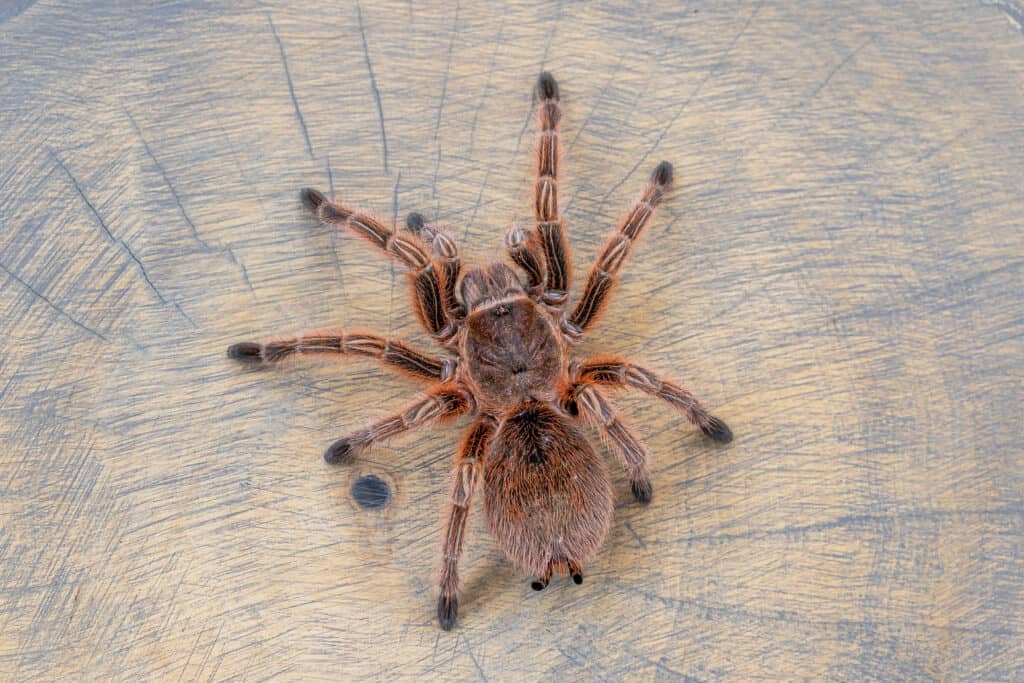
Chilean rose tarantulas
are the most common color of tarantulas sold by breeders.
©iStock.com/Svetlana Makarova
8 Different Colors of Tarantulas: Overview
Colorful tarantulas often have unique adaptations and behaviors compared to the less cryptically colored brown or earth-toned species. While they may not rely on camouflage in the same way that their brown counterparts do, they have other functions for their vibrant colors. Some colorful tarantulas, especially those with bright hues, exhibit warning coloration. These colors signal to potential predators that they are toxic or venomous, and consuming them would be harmful. This is called aposematism. Their vivid colors deter predators. Colorful markings and patterns are used in courtship displays to attract potential mates. Bright colors can play a role in mate recognition and selection.
Colorful tarantulas may use their coloration to regulate their body temperature. Darker colors can absorb more heat, helping them maintain optimal body temperatures in cooler habitats. Some tarantulas have adapted to specific ecosystems by mimicking the appearance of other organisms or elements in their surroundings. Mimicry can help tarantulas avoid predation by blending in with their surroundings and/or by appearing to be something less appealing to their potential predators.
8 Different Colors of Tarantulas: Chilobrachys natanicharum, The Rarest
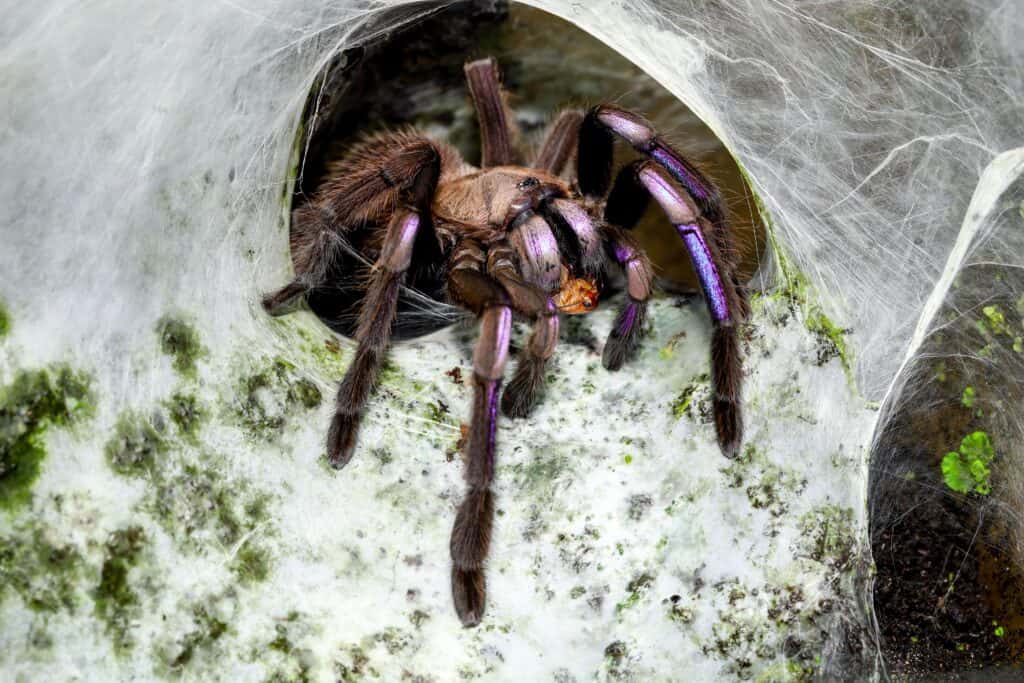
The electric blue tarantula is the rarest.
©monster_code/Shutterstock.com
Chilobrachys natanicharum, known in the pet trade as the electric blue, is the rarest color of tarantula. The species, native to Thailand, is highly sought after for its rare and brilliant blue and purple setae (hairs). Unlike animals whose coloration is a result of pigmentation, the electric blue and purple hues of Chilobrachys natanicharum are the result of light reflecting on the spider’s setae. Another animal with similar nanostructures is the peacock. This overall brown spider has blue, purple, and silver accents on its undercarriage. Electric blues can grow to be 6 inches (15 cm) or more in diameter. The spider’s scientific name Chilobrachys natanicharum, is a reference to two Thai real estate moguls who placed the winning bid in a charity auction to name the species.
8 Different Colors of Tarantulas: Poecilotheria metallica
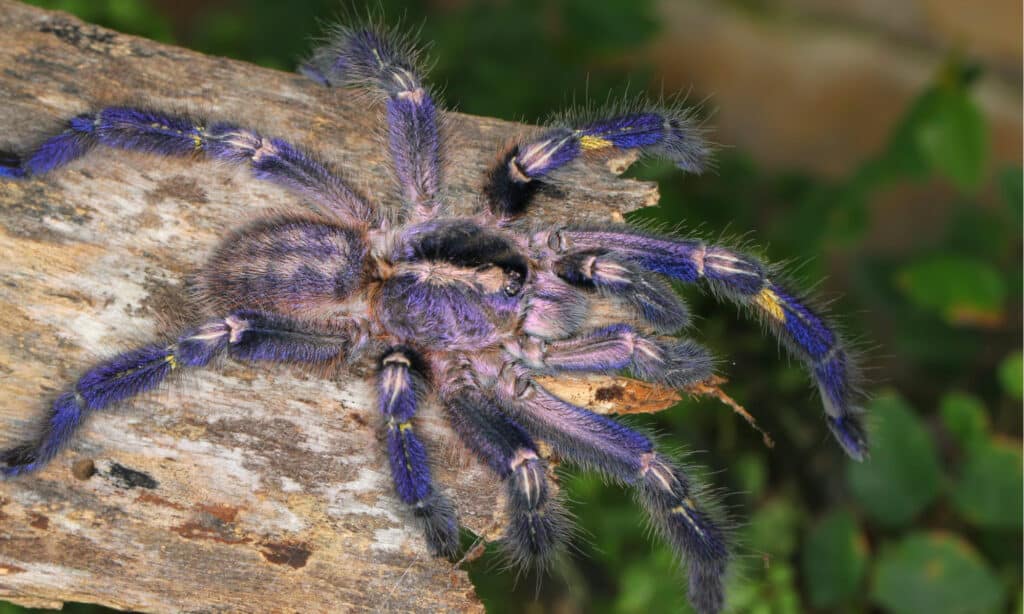
The peacock tarantula is native to a very limited area of Southeastern India.
©Pong Wira/Shutterstock.com
Poecilotheria metallica, commonly called the peacock tarantula or the Gooty sapphire ornamental is the only blue species in the genus Poecilotheria. Poecilotheria metallica is native to a very limited area of Southeastern India, specifically in the Gooty region of Andhra Pradesh. Its natural habitat includes dry deciduous and moist deciduous forests. Like other species in the Poecilotheria genus, the Gooty sapphire tarantula is arboreal, meaning it primarily resides in trees and other elevated locations.
They spin intricate funnel-shaped webs in their arboreal habitats, using them for shelter and ambushing prey. Adult females of this species can reach a leg span of around 5 to 6 inches (12 to 15 cm), while males are smaller.
8 Different Colors of Tarantulas: Omothymus violaceopes
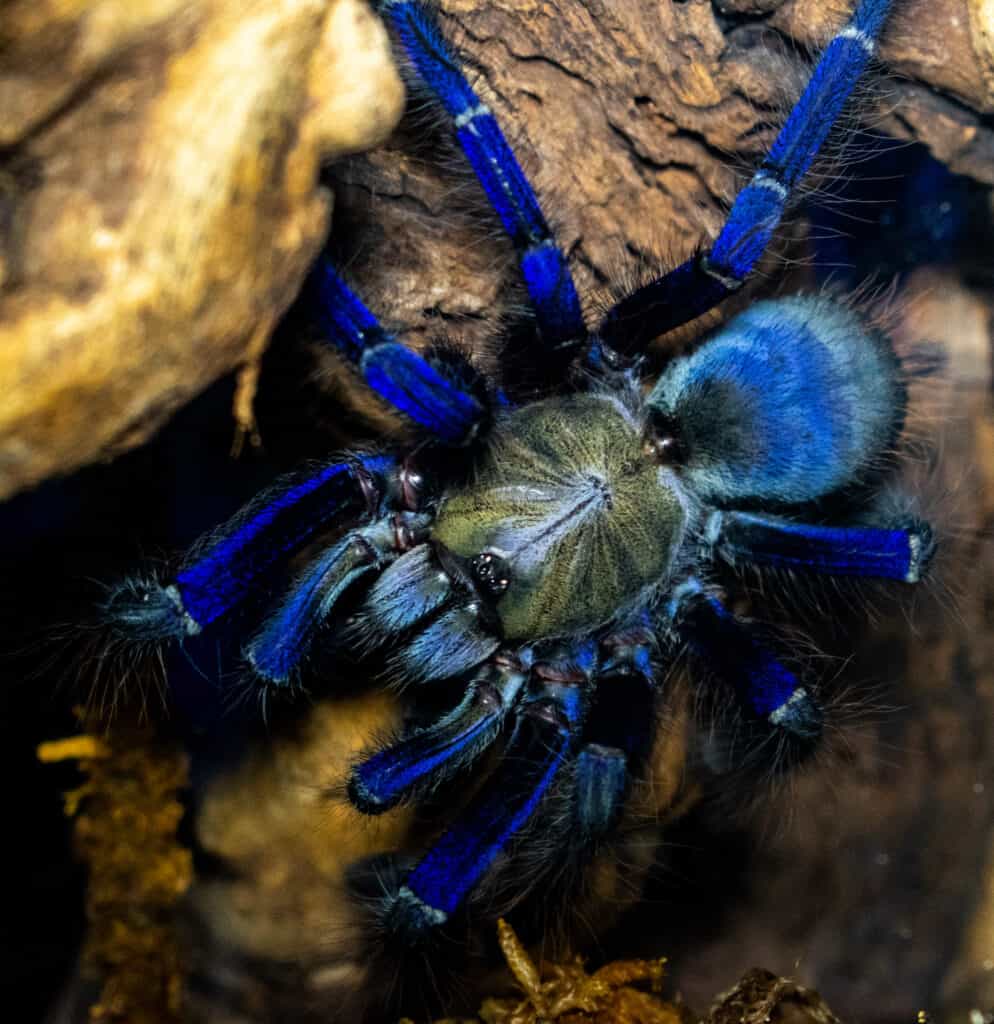
The Singapore blue tarantula (
Omothymus violaceopes) is named for its beautiful blue coloration.
©Blake Frye/Shutterstock.com
The Singapore blue tarantula (Omothymus violaceopes) is named for its beautiful blue coloration. Adult specimens exhibit a deep metallic blue on their carapace and legs. As with many tarantula species, females are generally larger and more brightly colored than males. This species is native to Southeast Asia, specifically found in countries like Singapore, Malaysia, and Indonesia. These enchanting spiders inhabit tropical rainforests and can be found in arboreal locations. Like other arboreal tarantulas, the Singapore blue is primarily tree-dwelling and constructs funnel-shaped webs to serve as both shelter and a place to ambush prey. They are moderately aggressive and may become defensive if threatened.
Avicularia geroldi
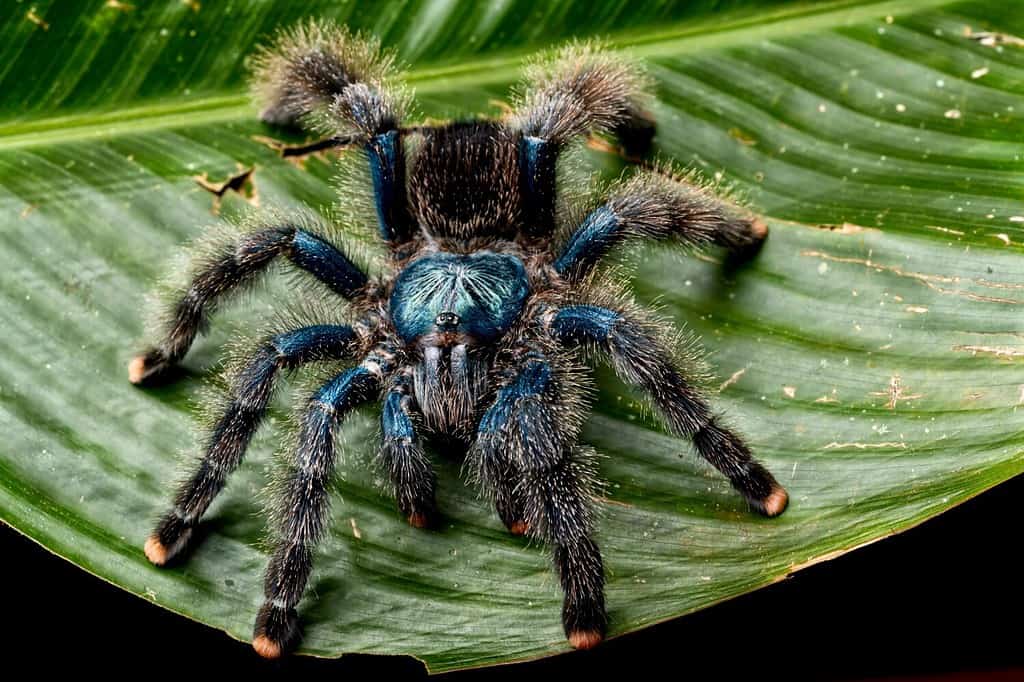
The coloration and patterns on their legs, especially their pink toes, make
Avicularia geroldia visually striking species.
©reptiles4all/Shutterstock.com
Avicularia geroldi, commonly referred to as the Brazilian blue gree pinktoe, is known for its beautiful coloration, featuring a combination of metallic blues, greens, and purples on its carapace, abdomen, and legs. The coloration and patterns on their legs, especially their pink toes, make them a visually striking species. They have a generally slender and elongated body shape, typical of arboreal tarantulas.
This species is native to the Caribbean Panama, and South America. In their natural habitat, pinktoes create silk-lined retreats in tree hollows, crevices, or under leaves. Adult females of this species have a leg span of 5 to 6 inches (12 to 15 cm). Males of the species are smaller.
8 Different Colors of Tarantulas: Haplopelma lividum
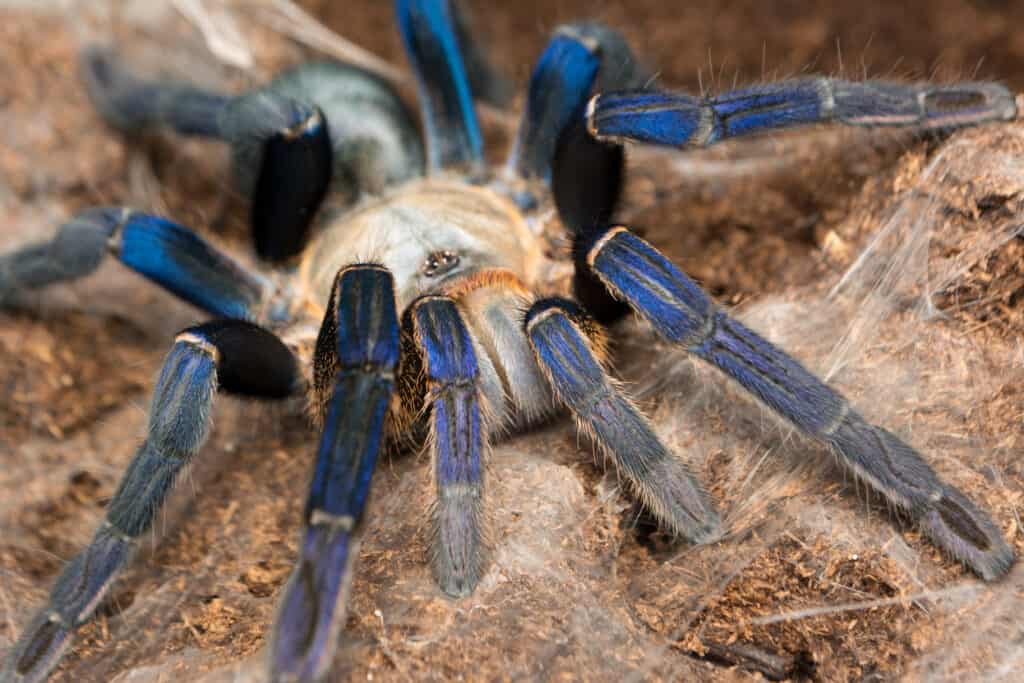
Mature
Haplopelma lividumhave black femurs and tibiae, which create a stunning contrast to their lighter body.
©xtotha/Shutterstock.com
Haplopelma lividum, commonly known as the cobalt blue tarantula, is a stunning and highly sought-after species of tarantula. Named for its striking cobalt-blue coloration, the species has a lightly colored carapace with a vivid blue abdomen and apendages. Mature specimens have black femurs and tibiae, which create a stunning contrast to their lighter body. Haplopelma lividum is native to countries such as Myanmar, Thailand, and Malaysia. Haplopelma lividum is a burrowing species. They construct burrows in the soil, which they use for shelter and as a place to ambush prey.
They are relatively aggressive and can be quick to defend their burrows if disturbed. Haplopelma lividum is popular and often kept as a pet. However, they are not recommended for beginners due to their potential for aggressive behavior. The cobalt blue tarantula possesses venom like all tarantulas. While their venom is not considered medically significant to humans (i.e., not life-threatening), a bite can still be painful and cause localized swelling and discomfort.
Grammostola pulchra
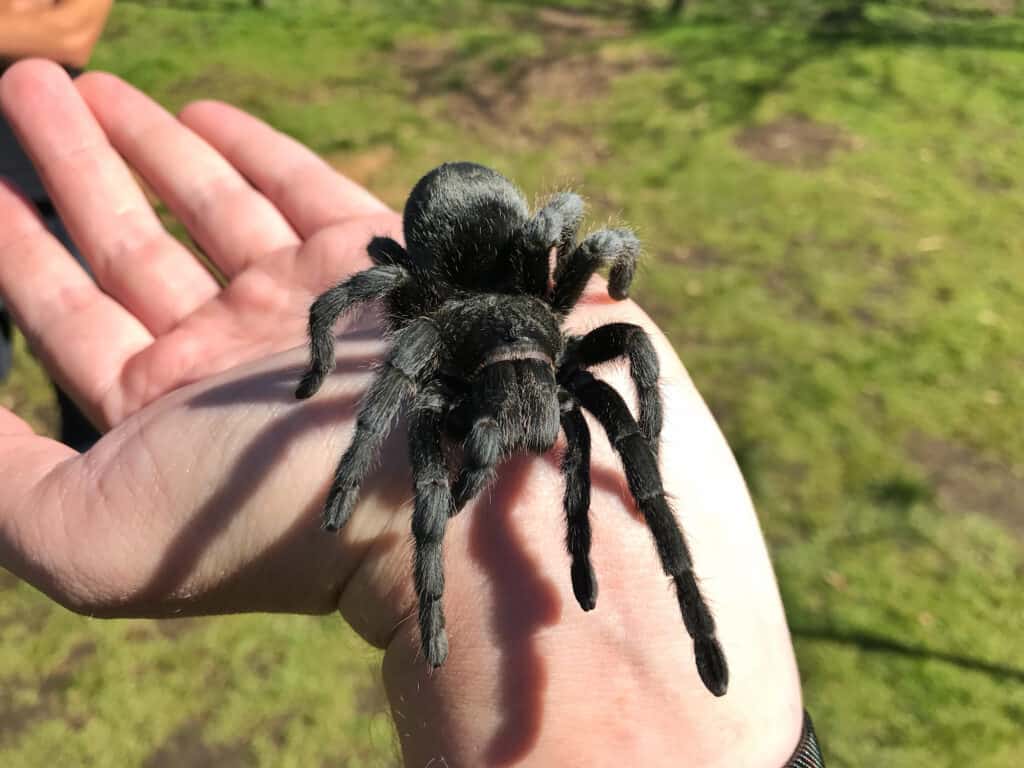
is native to Brazil. It inhabits a range of terrestrial environments, including savannas and forests.
©iStock.com/Willem Van Zyl
Grammostola pulchra, commonly the Brazilian black tarantula, is a species of tarantula known for its striking all-black appearance. It is named for its deep black coloration, which covers its entire body, including the carapace, abdomen, and legs. Its moderately sized body, has a diameter of 5 to 6 inches (12 to 15 centimeters). The species is native to Brazil. It inhabits a range of terrestrial environments, including savannas and forests. Brazilian black tarantulas are ground-dwelling. They live on the forest floor or in burrows that they dig. They are generally calm and docile, making them a popular choice among tarantula enthusiasts. Brazailian black tarantulas in captivity can live for an extended period, with some individuals living for 20 years or more.
Most Common in Nature: Aphonopelma hentzi
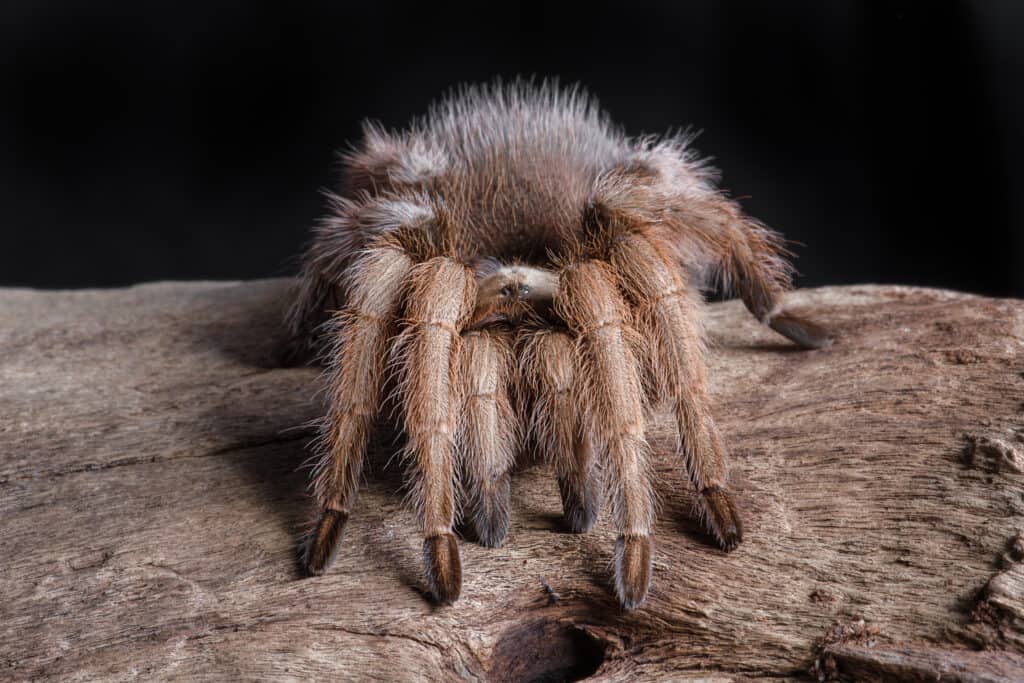
Found in the Southern United States,
Aphonopelma hentziis among the most common.
©Alan Tunnicliffe/Shutterstock.com
Found in the Southern United States, Aphonopelma hentzi, the Missouri, Oklahoma, or Texas brown taranula, is among the most common. Aphonopelma hentzi is brown or dark brown with a large body and long legs. Adult females are 4 to 6 inches (10 to 15 cm); males are generally smaller. Missouri brown tarantulas inhabit various terrestrial environments, including grasslands, deserts, scrublands, and forests. Texas brown tarantulas are ground-dwelling, preferring to live in burrows or silk-lined retreats they dig in the ground. Oklahoma brown tarantulas are solitary. They spend most of their lives in the same burrow. These tarantulas are primarily nocturnal, coming out at night to hunt for prey. Individuals of the species have lived for 15 years or more in captivity.
8 Different Colors of Tarantulas: Chilean Rose, Most Commonly Bred

The most commonly bred species of tarantula in the pet trade is
Grammostola rosea(formerly
Grammostola porteri), the Chilean rose tarantula.
©iStock.com/warren farnell
The most commonly bred species of tarantula in the pet trade is Grammostola rosea (formerly Grammostola porteri), the Chilean rose tarantula. This tarantula is native to Chile, particularly in the Northern and Central regions of the country, including the Atacama Desert, one of the driest places on earth. Chilean rose tarantulas have a leg span of 4 to 5 inches (10 to 13 centimeters). They vary from pinkish-red to brown, with a distinctive rose-colored carapace. They are relatively calm and docile compared to some other tarantula species.
The photo featured at the top of this post is © RebeccaBloomPhoto/ via Getty Images
Thank you for reading! Have some feedback for us? Contact the AZ Animals editorial team.






